If you’ve been wondering whether or not it’s possible to grow vegetables in the winter in the U.S. states of Oregon, Washington, and Northern California, then look no further, because it is! There are many varieties of vegetables available that can grow wonderfully in the Northwest’s mild winters.
Picking what to grow
To start off, you will need to find our what vegetables you will want to grow. Many vegetables can be planted in late summer or early fall, and will mature in winter. Some of the more popular winter vegetables include cabbage, mustard greens, onions, and beets. All of these vegetables can survive temperatures at freezing, or even below with proper care.
Raised garden beds
Raised garden beds are gardens that are elevated above the surrounding area. There are many varieties of raised beds using many different materials, including wood, bricks, and cinderblocks. If you choose to utilize a raised bed, then there are several things to keep in mind. Never use treated wood, as the chemicals from treated wood can contaminate edible vegetables, which might pose a health hazard when consumed. Between wood and soil to fill the bed, it can be a much costlier form of gardening, but I feel that the benefits outweigh the cost.
Raised beds, in the colder months, tend to have a soil temperature that is 5 to 10 degrees higher than the surrounding ground, and is a good way to offset problems with frosting and help contain heat where it needs to be. It also makes accessing your garden easier, because you don’t have to constantly bend over and get on your knees. Many home and garden stores sell pre-made raised garden beds, or you can buy the materials and create your own!
Cold frames and portable greenhouses
Another way to help contain and focus heat into your garden is with a cold frame, or portable greenhouse. These are very simple to make, and usually inexpensive. You can use wooden planks to create a windblock, to help keep the temperature constant inside your garden, and to help keep cold winter winds from damage your leafy vegetables. Another method is to create a portable greenhouse around your garden. To do this, simply surround the sides of your garden with a clear material, such as glass panels in a wooden frame, or see-through plastic. Doing this helps trap heat within it’s walls, and helps to focus sunlight onto your plants, raising the overall temperature of the garden.
Mulching
Mulching is covering the soil of your garden with an environmentally friendly, compostable material in order to help keep the soil beneath warmer. This is especially useful for many root vegetables, which are particularly sensitive to ground freezing. Some materials that are good to use include barkdust, sawdust, and shredded cardboard. Make sure to constantly check the soil beneath the mulch to ensure it is properly moist, and make sure not to cover your soil too deeply, as this can inhibit plant growth. Roughly 1 inch is enough to keep your garden warmer, and to help keep the soil from freezing.






